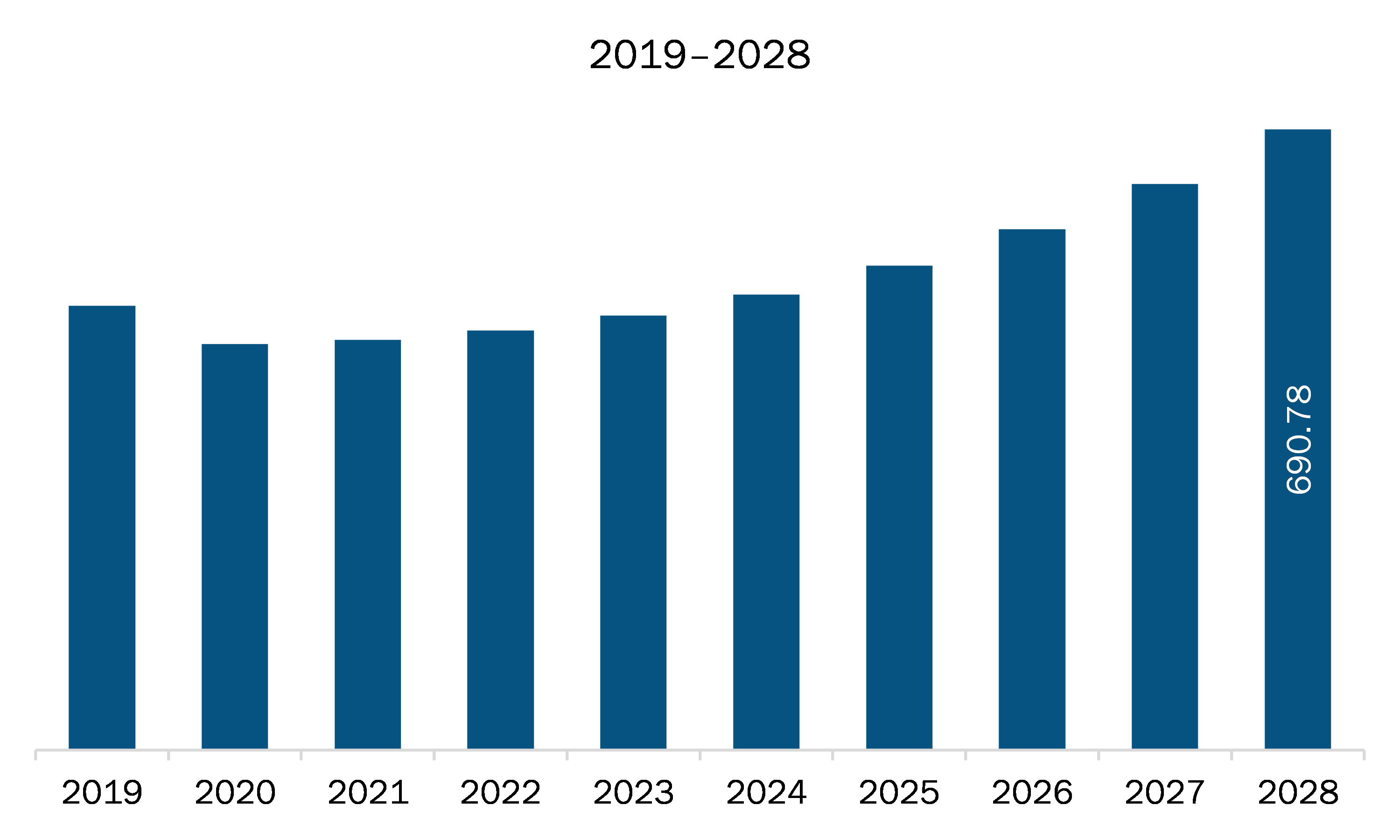The North America automated overhead crane market is expected to grow from US$ 456.56 million in 2021 to US$ 690.78 million by 2028; it is estimated to grow at a CAGR of 6.1% from 2021 to 2028.
The US, Canada, and Mexico are economies in North America. Increasing automation in the manufacturing sector is expected to surge the market growth. With the rising advancements in technology, almost every operation in the end-to-end industrial and manufacturing environment is becoming connected, intelligent, and smart. There are new forms of discrete and process manufacturing—sensors, connected objects and smart machines—that are evolving and changing the ecosystem of how exchange and collaboration between people, machines, data, and technologies were done earlier. Today’s digital plant of smart manufacturing heavily relies on collecting, sorting, and analyzing the data and information, and turning them into business values. The automation of cranes helps end users to gain sustainable competitive advantage, by enabling them with the ability to alter or change the material handling process with respect to market change on a real-time basis. The automated overhead cranes consist of a hoist and a trolley connected to a support structure which is also called a girder. The girder attached with the cranes permits the trolley and the hoist to travel from side-to-side along the length of the crane. The overhead cranes used in the manufacturing industry are distinguished into two main types – single girder crane and double girder crane. They have applications in manufacturing units of automotive, shipyards, aerospace, utility, and other industries. The rising adoption of automation in manufacturing industries is anticipated to drive the overhead cranes industry. The growing advancements in manufacturing processes support in creating high requirement for advanced machinery such as automated overhead cranes market across North America region.
In case of COVID-19, North America is highly affected specially the US. Due to various restrictions and limitations, construction, manufacturing, and metal & mining industries showed declined production. All these affected the related trading activities, leading to an economic slowdown. Moreover, owing to the imposition of strict containment measures, operations were permitted with limited number of employees only. This hampered the production activities in the US. Overhead cranes are essentially required at several job sites. These cranes help in moving heavy loads from one place to another, increasing the floor space, efficiency, and safety. Owing to restriction of trade operations, the region has experienced significant decline in the adoption of automated overhead cranes from demand side in 2020. The ship building industry in Canada suffered adversely due to this pandemic. Ship hulls are massive and are shaped irregularly. Moving and shifting heavy tools, equipment, components, and parts around the inside of a slanted hull can be difficult without the help of an overhead crane. A wide spanning heavy gantry cranes are required essentially for building ship hulls. However, gantry cranes were among the cranes that observed significant reduction in their sales. Moreover, as economies reopen and trade restriction get relaxed, the automated overhead crane market is expected to witness a steady growth in North America.
With the new features and technologies, vendors can attract new customers and expand their footprints in emerging markets. This factor is likely to drive the North America automated overhead crane market. The North America automated overhead crane market is expected to grow at a good CAGR during the forecast period.

- This FREE sample will include data analysis, ranging from market trends to estimates and forecasts.
North America Automated Overhead Crane Market Segmentation
North America Automated Overhead Crane Market – By Type
- Bridge Crane
- Gantry Crane
- Monorail Crane
- Jib Crane
- Others
North America Automated Overhead Crane Market – By Level of Automation
- Semi-Automated
- Fully Automated
North America Automated Overhead Crane Market – By Industry
- Manufacturing
- Shipbuilding
- Metals and Steel
- Others
North America Automated Overhead Crane Market, by Country
- US
- Canada
- Mexico
North America Automated Overhead Crane Market -Companies Mentioned
- Acculift
- DONGQI GROUP
- EMH, Inc
- EntsorgaFin S.p.A.
- Konecranes Oyj
- Kundel Industries Inc.
- Sumitomo Heavy Industries Material Handling Systems Co., Ltd.
- Weihua Group
North America Automated Overhead Crane Report Scope
| Report Attribute | Details |
|---|---|
| Market size in 2021 | US$ 456.56 Million |
| Market Size by 2028 | US$ 690.78 Million |
| CAGR (2021 - 2028) | 6.1% |
| Historical Data | 2019-2020 |
| Forecast period | 2022-2028 |
| Segments Covered |
By Type
|
| Regions and Countries Covered |
North America
|
| Market leaders and key company profiles |
|
- Historical Analysis (2 Years), Base Year, Forecast (7 Years) with CAGR
- PEST and SWOT Analysis
- Market Size Value / Volume - Regional, Country
- Industry and Competitive Landscape
- Excel Dataset
Recent Reports
Testimonials
Reason to Buy
- Informed Decision-Making
- Understanding Market Dynamics
- Competitive Analysis
- Identifying Emerging Markets
- Customer Insights
- Market Forecasts
- Risk Mitigation
- Boosting Operational Efficiency
- Strategic Planning
- Investment Justification
- Tracking Industry Innovations
- Aligning with Regulatory Trends






















 Get Free Sample For
Get Free Sample For